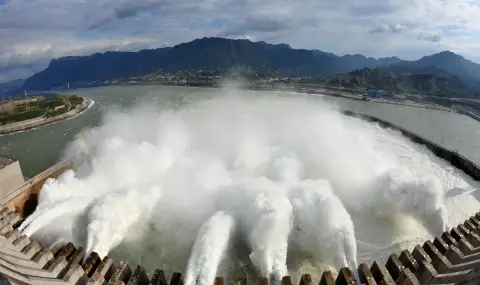In the XXI century, the technological achievements of mankind continue to impress with their scale and ambition. One of the vivid examples of such engineering genius is the largest hydroelectric plant in the world - the “Three Gorges“ dam. on the Yangtze River in China.
This huge structure, built to produce energy and prevent floods, not only changed the lives of millions of people, but also influenced the geophysics of the planet. One of the most discussed topics was the information that the dam slows down the Earth's rotation and changes its axis. Although these changes are extremely minor, the fact remains: a person, with the help of engineering solutions, can now influence global processes.
Project of the century: creation of the “Three Gorges” dam
The construction of the "Three Gorges" dam started in 1994 and completed in 2012. This project is considered to be the largest hydroelectric project in the world. The height of the dam is 185 meters, the length is over 2.3 kilometers. It is located on the Yangtze River, one of the most flooded rivers in China, which has been a threat to the population due to flooding for thousands of years.
However, the main purpose of the construction is not only flood protection, but also the production of electricity for the growing needs of the country. The hydroelectric plant connected to the dam is capable of generating up to 22.5 GW of electricity, which is equivalent to the energy consumption of several large cities.
Reservoir “Three Gorges“ is a colossal reservoir of water, the volume of which reaches 39.3 billion cubic meters. The water in this reservoir covers an area of about 632 square kilometers, which is larger than the size of many large cities in the world. Thanks to this enormous volume, the dam is able to effectively regulate water flows, preventing the devastating floods that have destroyed thousands of lives in the Yangtze River Basin in the past.
Deceleration of the Earth's rotation: myth or reality?
In 2010, rumors spread on the Internet that the construction of the “Three Gorges“ slows the Earth's rotation and even shifts its axis. This information generated great interest among both scientists and the general public. For the first time, scientists put forward the idea of a dam's influence on the Earth's rotation by analyzing the distribution of the water mass in the reservoir.
The essence of the phenomenon: when such a huge volume of water concentrates on one area of the Earth's surface, it affects the planet's moment of inertia - a physical quantity that determines the speed of its rotation. In essence, concentrating mass away from the planet's axis of rotation can slow its rotation, as happens, for example, with a figure skater stretching his arms out to the side, slowing his rotation speed.
According to the research, the construction of the dam actually affected the Earth's rotation, increasing the length of the day by 0.06 microseconds and shifting the axis about 80 centimeters to the east. However, it is worth noting that this effect is extremely small and does not have a significant impact on life on the planet. In addition, natural phenomena such as earthquakes or tsunamis can have a similar or even greater effect. For example, the 2010 Chile earthquake and the 2004 Southeast Asian tsunami also caused the Earth's axis to shift.
Scientific explanations: the moment of inertia and its role
To better understand how the “Three Gorges“ affects the Earth's rotation, we need to consider the concept of moment of inertia. Moment of inertia is a measure of a body's resistance to changes in its rotational speed. The further the mass is from the axis of rotation, the greater the moment of inertia. In the case of the Three Gorges Dam, the huge volume of water collected at a distance from the Earth's axis of rotation increased the planet's total moment of inertia, resulting in minimal deceleration of its rotation.
Displacement of the earth's axis: consequences of mass movement
Research shows that between 1993 and 2010, the Earth's axis shifted 80 centimeters to the east. One of the reasons for this phenomenon is the construction of the "Three Gorges" dam, as well as other human interventions such as groundwater extraction. Scientists estimate that during this period, humans pumped about 2,150 gigatons of water from underground sources, which also affected the redistribution of mass on the planet's surface.
Although the axis shift seems small, it is important evidence that human activity can affect physical processes on Earth. These changes may be small in everyday life, but they can have long-term consequences for the climate and other processes on the planet. However, the significance of the axis shift in the context of global changes is still a subject of scientific debate, since the influence of human activity on the Earth's axis remains much less significant than, for example, the influence of tectonic processes.
Broad implications of engineering projects
Reservoir “Three Gorges“ has become a symbol of both human capabilities and responsibility for impacting nature. This structure is certainly an example of how humanity in the Anthropocene era can influence global processes, including geophysical phenomena. Although the dam's effect on slowing the Earth's rotation is minimal, its very existence highlights the need for more careful environmental impact assessment of such large-scale engineering projects.
You can see detailed statistics on average property prices in Bulgaria by cities and neighborhoods HERE
The news was published on the basis of an information exchange agreement between Fakti.bg and Kazinform
